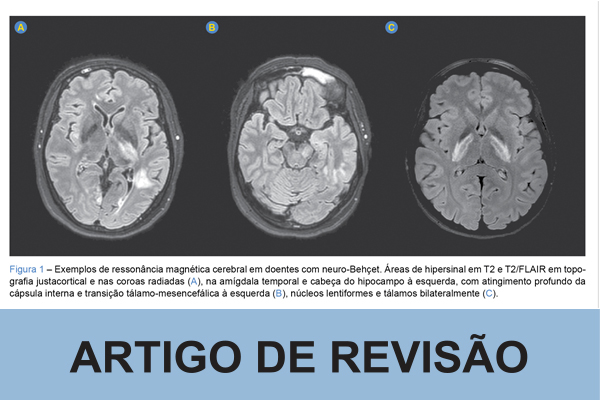SOCIAL MEDIA
Portuguese Medical Association's Scientific Journal

Behçet’s disease is a relapsing multisystemic inflammatory syndrome characterized by recurrent oral and/or genital ulcers, uveitis, arthritis, skin lesions, and gastrointestinal and neurological involvement. Neuro-Behçet corresponds to nervous system involvement and is one of the most severe complications of Behçet disease. It occurs in 3% to 30% of cases and is categorized into parenchymal (most common) or non-parenchymal disease. The most common manifestation of parenchymal neuro-Behçet is meningoencephalitis with involvement of the brainstem, where patients present with cranial neuropathies, encephalopathy, sensory-motor syndromes, epilepsy, or myelitis. The main non-parenchymal manifestation is cerebral venous thrombosis. Neuro-Behçet has a predominantly subacute course, with remission within weeks, or clinical progression in one third of the cases. The diagnosis is essentially clinical and diagnostic tests help to corroborate the suspicion, distinguish from differential diagnoses, and exclude complications. Brain magnetic resonance imaging allows the identification of acute lesions (hypointense or isointense on T2-weighted and hypointense on T1-weighted sequences) contrast-enhanced, and chronic lesions characterized by non-contrast enhanced small lesions and brainstem atrophy. If non-parenchymal involvement is suspected, cerebral veno-magnetic resonance imaging /computed tomography should be performed. Cerebrospinal fluid shows elevated proteinorachia and pleocytosis in parenchymal and no changes in non-parenchymal neuro-Behçet (except increased opening pressure). Outbursts of parenchymal disease
should be treated with high dose intravenous corticosteroid therapy, with subsequent switch to oral corticoids, followed by biologic therapy, usually an anti-TNF. The treatment of cerebral venous thrombosis is controversial and may consist of a combination of corticosteroids and anticoagulation. Given the severity of this entity and the fact that it is potentially treatable, it is essential to recognize it early. Therefore, a narrative review was carried out in order to collate the most relevant information on neuro-Behçet, to help clinicians manage this type of patient.